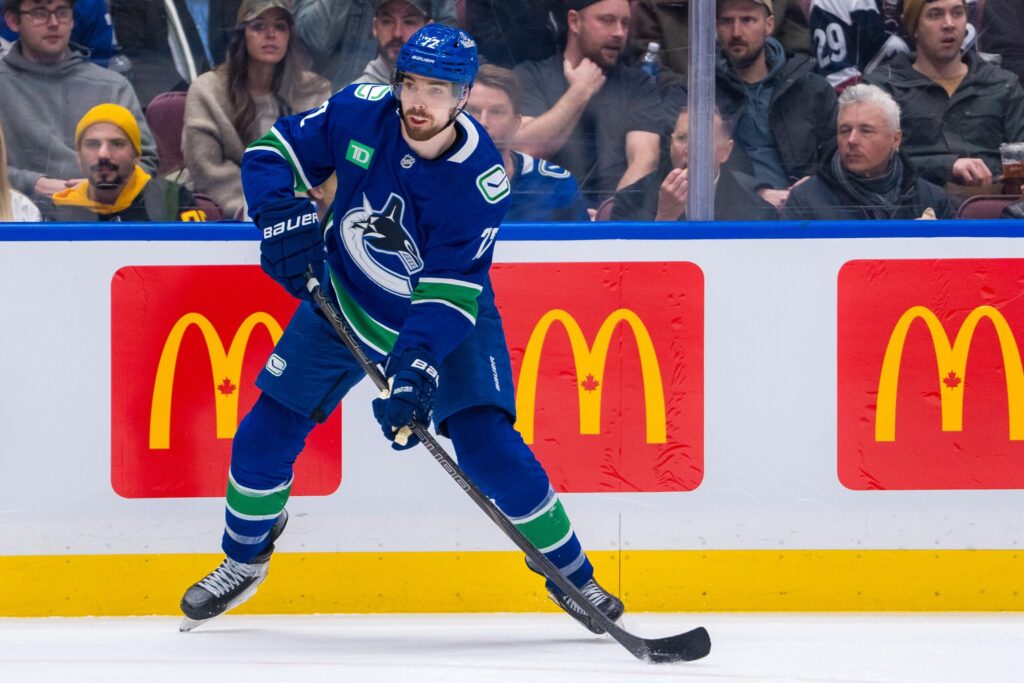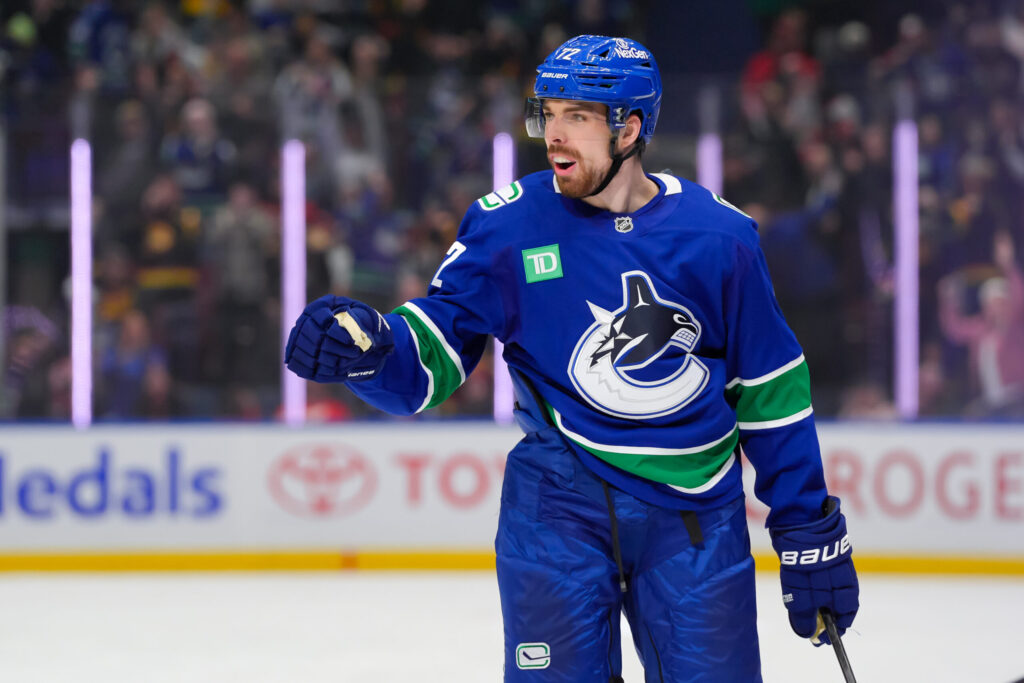In the high-stakes poker game that is NHL team building, every general manager has a type of bet they can’t resist. For some, it’s the hulking reclamation project. For others, it’s the undersized offensive dynamo. For Patrik Allvin and the Vancouver Canucks, the acquisition of Filip Chytil represents a very specific, and potentially franchise-altering, wager: a bet on talent to conquer fragility.
When Chytil was brought in from the New York Rangers, the move was met with a mix of intrigue and trepidation. Here was a first-round pick, blessed with the skating, size, and skill to be a legitimate top-six centre in the league. He was also a player whose medical chart had more pages than a Tolstoy novel.
Also on the EDGE – Blue Line Bonanza: Why the Canucks’ Defence is Built for a Deep Playoff Run
After a tantalizing but ultimately truncated 15-game debut in a Canucks sweater last season, the 25-year-old Czech centreman is once again the subject of cautious summer optimism. Recent reports have Chytil declaring himself “100% healthy” and back to a full training regimen. The words sound great. They are exactly what a team and a fanbase, desperate for a long-term solution down the middle, want to hear. But with a history like his, the question isn’t how he feels on a sunny August afternoon. The question is whether that feeling can survive the brutal grind of an 82-game NHL season.
Clearing the Fog: Chytil Declares Himself Fit for Battle
For any professional athlete, the offseason is a time for renewal. For a player coming off a significant injury, it’s a period of intense, focused rehabilitation and profound mental fortitude. For Chytil, this summer represents something more: a chance to finally turn the page.
According to his camp, Chytil has been “getting ready for the new season full-time since the beginning of May.” This is a crucial detail. It suggests this isn’t a rushed, last-minute push to be ready for camp, but a deliberate, months-long process to rebuild his body and confidence. After another concussion ended his 2024-25 campaign and forced him to miss the final 16 games, this extended period of preparation is the best-case scenario.
“I’m very much looking forward to my first full season as a Vancouver Canuck,” Chytil has stated, and you can almost feel the eagerness in the words. The trade from the Rangers was billed as a “fresh start,” a necessary move for a player who, along with the organization that drafted him, felt it was simply “the right time to part ways.” New York had seen the flashes of brilliance—like his 22-goal, 45-point breakout in 2022-23—but they had also lived through the frustrating, unpredictable absences.
Also on the EDGE – Canucks Goaltending: Confidence Between the Pipes
Now, in Vancouver, the slate is theoretically clean. He’s no longer the kid trying to crack a veteran lineup on Broadway; he’s the man penciled in to fill the team’s most glaring positional need. This psychological shift cannot be overstated. With just over six weeks until training camp, the narrative is one of unbridled positivity. Chytil is healthy, motivated, and poised to make good on the promise that has followed him his entire carAlso on the EDGE – eer. But as anyone in the hockey world knows, summer promises are written in sand, easily washed away by the first hard check into the boards.
Slotting In: The High-Stakes Game of the 2C
Let’s talk X’s and O’s. Assuming Chytil arrives at camp healthy and stays that way, where does he fit? The answer is simple and tantalizing: right behind Elias Pettersson as the second-line centre.
In his best moments, Chytil is a dynamic offensive player. He possesses the speed to drive the play through the neutral zone and the hands to make defenders miss in tight spaces. At 6-foot-2, he has the frame to protect the puck and win battles along the boards, though applying that size consistently has been a developmental focus. If he can anchor a line, perhaps with wingers like Jake DeBrusk and Conor Garland, he has the potential to easily surpass the 40-point plateau and flirt with 200 shots on goal.

This is where the fantasy hockey nerds and the real-world GMs find common ground. The difference between Chytil as a 2C playing 17-18 minutes a night with second-unit power-play time, and Chytil as a sheltered 3C playing 13-14 minutes, is monumental. The former is a key contributor to a playoff team. The latter is a luxury piece whose roster spot could be filled by a more reliable, if less dynamic, player. The Canucks didn’t trade for a third-line centre. They traded for a solution. The entire calculus of their offseason hinges on Chytil being the player they project him to be, not the one his injury history suggests he might become.
The Specter of Concussions
We can’t dance around it any longer. The single biggest variable in Chytil’s career is the health of his brain. In the modern NHL, the word “concussion” lands with a chilling thud. For a player with Chytil’s history, it’s a constant, unspoken fear.
Let’s recap the timeline, because it’s sobering. His 2023-24 season with the Rangers was essentially a write-off; he played just 10 contests due to a suspected concussion and the subsequent, complicated recovery. Then came the trade, the “fresh start.” He suited up for 15 games as a Canuck, started to look comfortable, and then—bam. Another concussion, sustained in mid-March, shutting him down for the year. This wasn’t a fluke. It was a pattern.
Multiple concussions are a terrifying reality in contact sports. The brain doesn’t heal like a broken bone or a torn ligament. Each subsequent trauma can lower the threshold for the next one, and recovery times can become increasingly unpredictable. We’ve seen careers of brilliant players like Pat LaFontaine, Paul Kariya, and Marc Savard cut short or irrevocably altered by head injuries.
Also on the EDGE – A Deep Dive into the Canucks’ Next Wave of Talent
This is the elephant in the room for the Canucks. They acquired a 25-year-old with the upside of a top-tier center but the risk profile of a player ten years his senior. While Chytil’s enthusiasm is infectious and his reports of a full recovery are genuinely welcome news, everyone involved—from management to the medical staff to Chytil himself—understands the precariousness of the situation. Every hit he takes, every awkward fall, every collision in the corner will be met with a collective held breath.
The Verdict: Hope, with a Hefty Asterisk
So, what is a realistic expectation for Chytil in the 2025-26 season? The answer is a frustrating, “It depends.”
The best-case scenario is a revelation. Chytil, empowered by a new environment and a fully healthy offseason, finally puts it all together. He plays 70-plus games, solidifies the second-line centre position, posts 20 goals and 50 points, and becomes a core piece of Vancouver’s future. The Canucks’ gamble pays off handsomely, and Allvin looks like a genius.
The worst-case scenario is tragically predictable. He suffers another head injury early in the season, leading to another lengthy, uncertain absence. The Canucks are back to square one, patching the 2C hole with less-than-ideal options, and the conversation shifts from Chytil’s on-ice potential to legitimate concerns about his long-term health and career viability.
The reality will likely fall somewhere in between. But for the Canucks, this is a calculated risk they had to take. The potential reward—a cost-controlled, young, skilled second-line centre—is simply too high to ignore. They are betting on their environment, their medical team, and, most importantly, on the resilience of the player himself.
As fans and analysts, we can only watch and wait. The summer reports are a welcome dose of optimism. But the true test begins in October. Chytil’s first full season in Vancouver is a story of immense potential shadowed by profound risk. It is a story of hope, but a hope that comes with a hefty, unavoidable asterisk.
Created with the aid of Gemini AI
